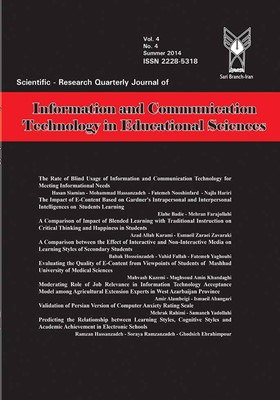مقایسه تأثیر رسانه تعاملی و غیرتعاملی بر نوع سبکهای یادگیری دانشآموزان دوره راهنمایی
الموضوعات :
Infomartion Technology
بابک حسین زاده
1
,
وحید فلاح
2
,
فاطمه یعقوبی
3
1 - استادیار گروه علوم تربیتی، دانشگاه آزاد اسلامی واحد بابل، بابل، ایران
2 - استادیار گروه علوم تربیتی، دانشگاه آزاد اسلامی واحد ساری، ساری، ایران
3 - کارشناس ارشد تکنولوژی آموزشی، دانشگاه آزاد اسلامی واحد ساری، ساری، ایران
تاريخ الإرسال : 05 الإثنين , شوال, 1434
تاريخ التأكيد : 14 الأربعاء , ذو الحجة, 1435
تاريخ الإصدار : 05 الجمعة , شوال, 1435
الکلمات المفتاحية:
سبکهای یادگیری,
رسانه تعاملی,
رسانه غیرتعاملی,
دانشآموزان,
ملخص المقالة :
هدف از پژوهش حاضر، مقایسه تأثیر آموزش مبتنی بر رسانه تعاملی و آموزش مبتنی بر رسانه غیرتعاملی بر سبکهای یادگیری دانشآموزان میباشد. روش پژوهش از نوع شبه آزمایشی با طرح پیشآزمون - پسآزمون با گروه کنترل میباشد. جامعه آماری شامل تمامی دانشآموزان مقطع راهنمایی شهرستان بابل در سال 1392 میباشد. 160 نفر از دانشآموزان، به روش تصادفی چندمرحلهای انتخاب و به دو گروه آزمایش و کنترل تقسیم شدند. گروه آزمایش، آموزش با رسانههای تعاملی شامل نرمافزار آموزشی ActivInspire، تخته هوشمند و پاورپوینتهای آموزشی دریافت کردند، در حالی که گروه کنترل تحت آموزش غیرتعاملی مدرسه بودند و آموزش رسانه تعاملی را دریافت نکردند. ابزار پژوهش، پرسشنامه سبک یادگیری کلب (Kolb) بود. برای تجزیه و تحلیل دادهها از آزمون تحلیل کوواریانس استفاده شد. نتایج نشان داد که در مرحله پسآزمون، نمرات سبکهای یادگیری در آزمودنیهای گروه آزمایش در مقایسه با گروه کنترل به طور معناداری افزایش یافته است. در مجموع، نتایج حاکی از آن بود که آموزش مبتنی بر رسانههای تعاملی تأثیر بیشتری بر نوع سبکهای یادگیری همگرا، واگرا، جذبکننده و انطباقیابنده دانشآموزان در مقایسه با آموزش مبتنی بر رسانههای غیرتعاملی دارد.
المصادر:
Ahmadi, G. R., & Shahsavani, S. (1999). Examining the influence of video tape of matemathic lesson on high school student’s academic achievement. Knowledge & Research in Applied Psychology, 1(2), 63-72. (in Persian).
Aist, G. (2002). Helping children learn vocabulary during computer-assisted oral reading. Educational Technology & Society, 5(2), 147-163.
Elliot, S. (2010). Multimedia in Schools: A study of web-based animation effectiveness. Retrieved from http://center.uoregon.edu/291/
Gardner, J., Emmett, W., Charyl, A., & Schweder, B. (2003). Enhaning interdisciplinary instruction in general and special education. Remedial and Special Education, 24(3), 161-172.
Hoseiny Largani, M., & Seif, A. A. (2001). Comparing university student learning style's according to gender, educational Level and major. Research and Planning in Higher Education, 19, 87-99. (in Persian).
Jannesare Vatan, F., Sharifi, M., & Hasanabadi, H. (2013). Instructional efficiency in multimedia learning environment: The moderating effect of controlling the pace of presenting on modality. Education and Learning, 1(2), 1-11. (in Persian).
Kayes, D. C. (2005). International validity and reliability of Kolb’s learning style inventory version 3, 1999. Journal of Business and Psychology, 9, 15-28.
Kharamide, Z. (2006). Comparing the influence of education by the aid of interactive multi-media (cd) and non-interactive media (film) on increasing speed and learning exactness and memorial of girl student in biological lesson in high school on Tehran/region 19. Unpublished Master Thesis, Tehran: Allameh Tabatabaei University. (in Persian).
Krejcie, R. V., & Morgan, D. W. (1970). Determining sample size for research activities. Educational and Psychological Measurement, 30, 607-610.
Mayer, R. E., & Moreno, R. (2003). Nine ways to reduce cognitive load in multimedia learning. Educational Psychologist, 38, 43-52.
Meelissen, M. R. M., & Drent, M. (2008). Gender differencies in computer attitudes: Does the school matter? Computers in Human Behavior, 24(3), 969-985.
Norozi, D., Ahmadzade, B., A., & Agha Barati, N. (2011). Multi-media education influence on the amount of learning and matemathic memorial in self-left boy students. Exceptional Individual Psychology, 1(4), 23-51. (in Persian).
Samadi, M. (2008). Investigating the immediate and sustainable effectiveness of self-regulation strategies instruction on self-regulatory strategies and math problem solving ability. Educational Innovations, 7(27), 79-95. (in Persian).
Seif, A. A. (2000). Training psychology: Learning and education psychology. Tehran: Agah. (in Persian).
Seif, A. A. (2010). New educational psychology (10th Edition). Tehran: Doran. (in Persian).
Silverman, R., & Hines, S. (2009). The effects of multimedia-enhanced instruction on the vocabulary of English/language learners and non English language learners in pre-kindergarten through second grade. Journal of Educational Psychology, 10(2), 305-314.
Webster's Third New Instructional Dictionary. (1969). U.S.A: G & C. Merriam Company Publishers.
Willcoxson, L. (1985). Kolb lerning styles inventory (1985): Review and further study of validity and reliability. Biritish Journal of Educational Psychology, 66, 252-261.
Yavari, M., Yaryari, F., & Rastgarpour, H. (2006). The utility of a computer-assisted instructional software (hesabyar) for teaching mathematics to students with dyscalculia. Research on Exceptional Children, 6(3(21)), 713-734. (in Persian).
Zareii Zavaraki, E., & Gharibi, F. (2011). The Impact of instructional multimedia on learning and retention of mathematics of fourth grade educable Mentally retarded girl students of elementary schools in Arak city. Exceptional Individual Psychological, 2(5), 1-20. (in Persian).


